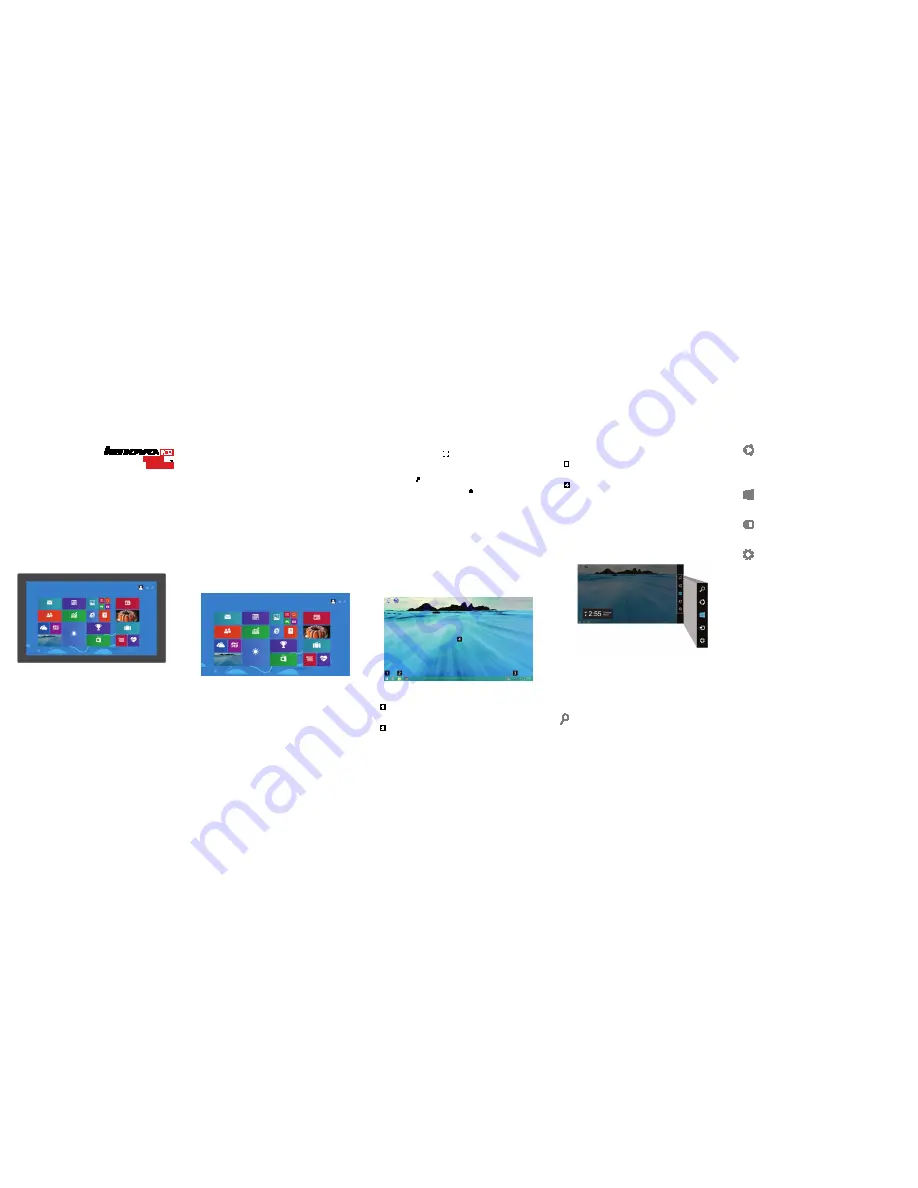
Getting Started with
Windows 8.1
Windows 8.1 Support Center @ Lenovo
support.lenovo.com/windows8.1
Hello. We at Lenovo
®
developed this publication to help you get started
with the Microsoft
®
Windows
®
8.1 operating system. Whether you are a
new computer user or are simply new to Windows 8.1, we are confident
that you find this information helpful now and in the future.
Contents
•
Start screen
•
Desktop
•
Charms
•
Touch gestures and mouse controls
•
More Windows 8.1 tips
Start
screen
The Start screen is a simplified interface optimized for touch screens,
but equally usable with a mouse or other pointing device. Each tile on
the Start screen is associated with an app, Web site, playlist, person, or
whatever else you find important. Some tiles are animated to show you
the latest information, such as status updates or weather forecasts.
Notes:
•
The user interface might look slightly different from the illustrations
due to variations within Windows updates.
•
The features marked with an asterisk (*) are not supported in
some earlier versions of Windows 8.1.
You can do the following on the Start screen:
•
To open the associated app or function, tap or click the tile.
•
*To get to the Apps screen, slide up from the middle of the screen,
or click the down arrow near the bottom-left corner of the
screen.
•
To get to the desktop, tap or click the desktop tile.
•
*To search for available apps, settings, and files, tap or click the
search icon in the upper-right corner of the screen.
•
*To shut down, restart, or set your computer to power-saving
modes, tap or click the power icon in the upper-right corner of
the screen.
•
*To get to the taskbar, move the pointer to the bottom edge of the
screen and slide down to show the taskbar.
Desktop
The Windows 8.1 desktop is similar in appearance and function to the
desktop in earlier Windows versions. You can run traditional Windows
programs, manage files, and access Control Panel settings on the
desktop. Functions, such as search and navigation to programs and
settings, which were on the Start menu of Windows 7 and earlier
versions are now provided by the charms in Windows 8.1. See
“Charms” later in this document for details.
The desktop provides the following components:
Windows Start-screen control:
This control is located at the
bottom-left corner of the screen. Tap or click this control to get
to the Start screen.
Taskbar:
This component is located at the bottom of the
screen, next to the Windows Start-screen control. It contains
shortcuts to some apps. You can pin additional shortcuts to
the taskbar. The taskbar also displays icons for open desktop
programs.
Toolbar:
This component is located at the bottom of the
screen near the right edge. It contains shortcuts to certain
tools, features, and settings.
Desktop area:
This is the largest area of the screen and is
where you can add icons as shortcuts to your programs and
arrange the icons to your preference. You also can customize
the appearance of your desktop.
Charms
The charms enable you to navigate throughout Windows 8.1, perform
searches, access settings, share files, and so on. You can open the
charms from the Start screen, desktop, or any other workspace.
To open the charms, do one of the following:
•
Mouse:
Move the pointer to the top-right corner or bottom-right
corner of the screen.
•
Touch:
Swipe in from the right edge of the screen.
•
Keyboard:
Press the Windows logo key + C.
The following sections describe the navigation functions supported on
both the desktop and the Start screen or apps.
Search
Search for available apps, settings, and files.
Share
Share files, Web links, and other items with others. Full support is
limited to Windows Store apps. Open a Windows Store app, select the
item you want to share, open the charms, and then tap or click
Share
.
Start
Go to the Start screen or the last app you were using.
Devices
Interact with devices connected to your computer.
Settings
Customize your computer settings.


